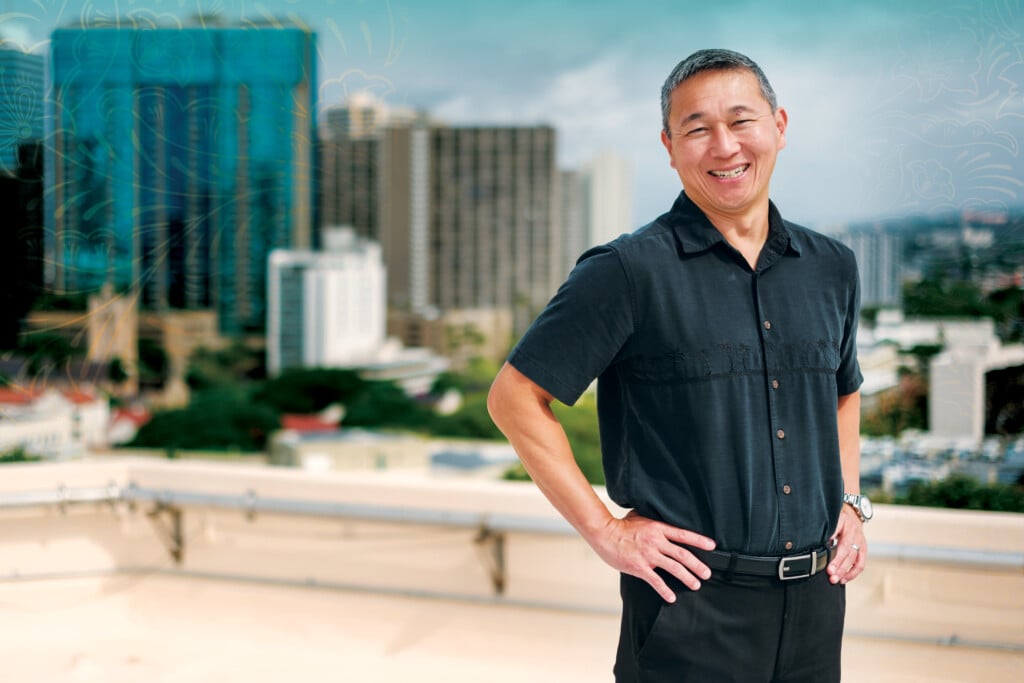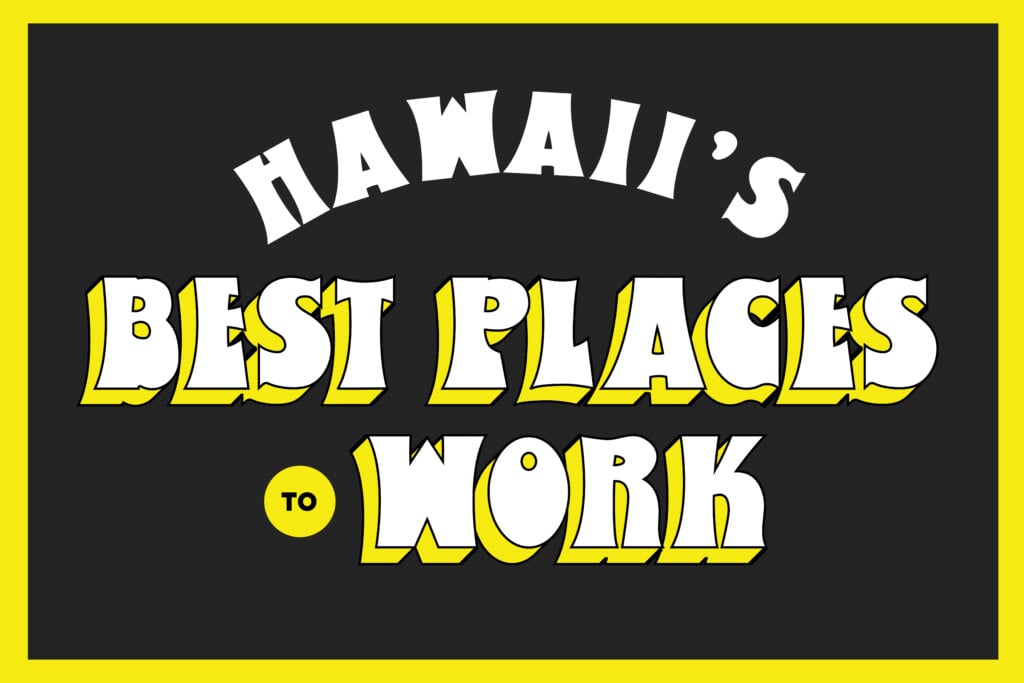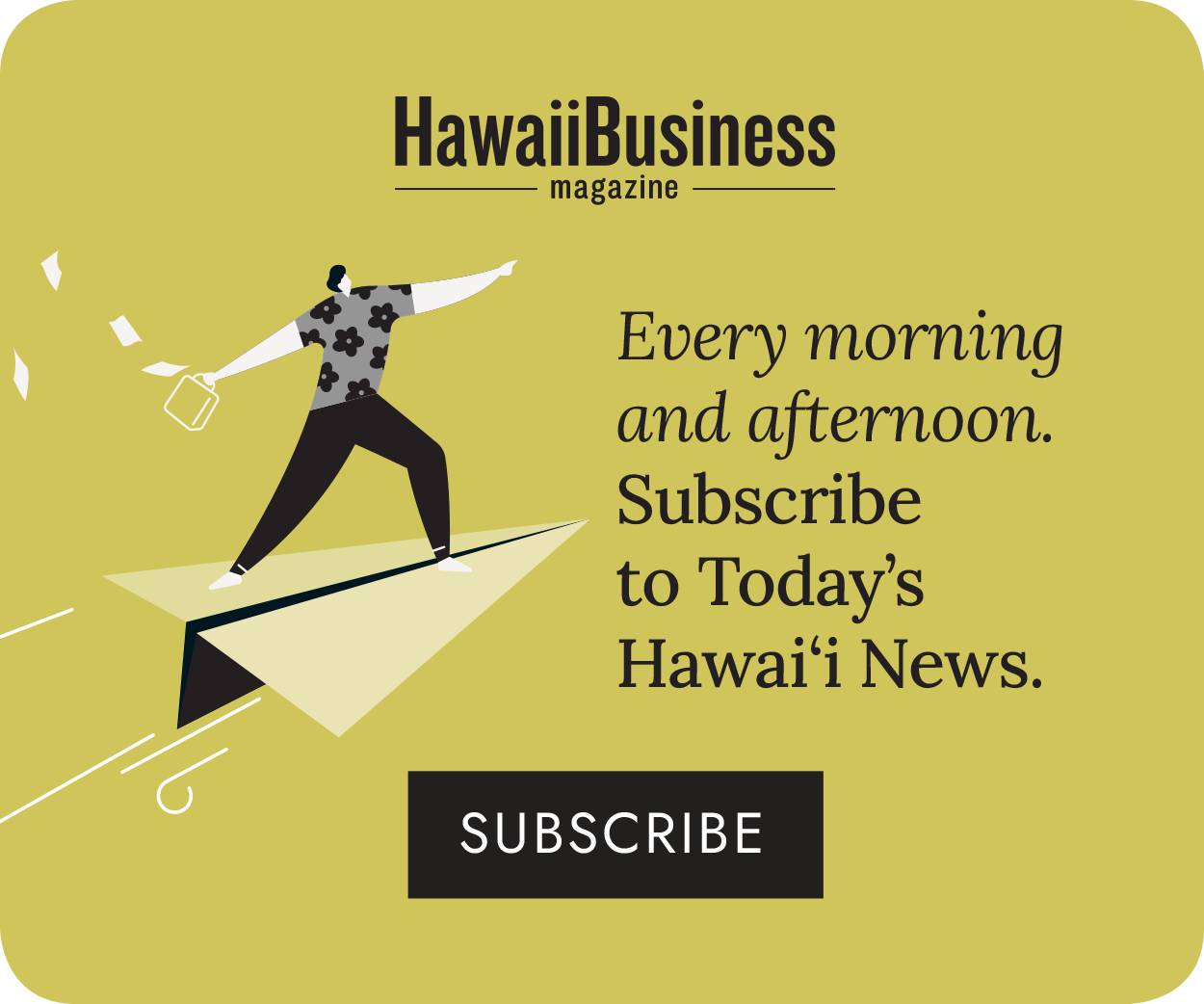Reversing Hawaii’s Brain Drain

Five steps local leaders are taking right now to persuade bright young kamaaina to stay home or come back
Tony Marzi is the kind of kamaaina that Hawaii’s business and community leaders hope will come home. The 32-year-old grew up on Hawaii Island, graduated in computer science from UH Hilo, founded a coworking space called Hawaii TechWorks, once ran for public office, and now has nearly a decade of professional experience in high tech.
Despite moving back twice to explore career opportunities, however, Marzi settled elsewhere. He recently accepted a job in Washington, D.C., managing a team of 80 within a global aerospace company, purchased a condo and will soon be joined by his girlfriend, a teacher from Honolulu.
“I know there are a lot of good folks who have made it work in Hawaii. But when your talented workforce must compromise between compensation and location, you’re going to lose a lot of good people. And ultimately it’s harmful to the business community,” he says.
Marzi’s journey reflects one of the state’s biggest challenges – brain drain – the departure of talented young adults for better opportunities elsewhere.
“When your talented workforce must compromise between compensation and location, you’re going to lose a lot of good people. ”
— Anthony Marzi
“We have two strong mitigating factors,” explains Joan Husted, former executive director of the Hawaii State Teachers Association. “One is our pay in many fields isn’t competitive. And two, even if you can find a well-paying job, you can’t find a place to live. Where else in the country does a moderately priced condominium come in at 400k?”
Because the number of people moving away is greater than the number moving to the state, Hawaii has suffered a net loss of 30,000 residents since 2010. Thus, while young adults seek more lucrative opportunities elsewhere, ironically, critical jobs back home remain unfilled.
“We don’t graduate enough teachers to fill the vacancies we have. We have to hire people from the Mainland, but they only stay a few years, as the cost of living breaks them. In medicine, we’re short of doctors and nurses,” says Husted.
The community leaders, parents and young professionals interviewed for this piece all agreed there is no silver bullet or simple legislation that can fix the problem.
“Solving brain drain is like solving homelessness. It’s such a high-level issue, it’s difficult to say we’re going to do this, this and this and be able to fix it. There are so many factors. Even if you figure out two or three things, you’re not going to see returns on these things for years,” says state representative Jarrett Keohokalole, whose district runs from Kaneohe to Waiahole.
While the problem is complex and enormous, multiple sectors are tackling brain drain from different angles. “Every problem has a solution,” Husted says. “The question is: Do we have the will to put our heads together to keep our best and brightest in the state? Can we train them for the jobs that are available? And can we attract more business? But this is not just a business problem or a government problem. This is a community problem.”
Here are five ways Hawaii’s leaders and residents are working to ensure young adults can envision a prosperous and fulfilling future in Hawaii.
#1. Fight the stigma associated with attending college in-state
Cody Funakoshi admits she never considered going to college in-state. She graduated from Punahou School and then from the University of Miami two years ago in civil engineering and is moving to San Francisco to pursue a career in user-experience design.
“For everyone I knew, the plan is you graduate from high school, go to school on the Mainland, get a couple of years of experience and ultimately make it back to Hawaii. I don’t know if it was the culture of my school, but our counselors only talked about Mainland colleges, and it seemed like there was a stigma attached to staying home, as if the people who go to UH are less ambitious. It’s like, aren’t you going to go out and be cultured and get off this rock?” she says.
Funakoshi’s perspectives are hardly unique. For those families who can afford it, sending high school graduates to the Mainland for college is often a rite of passage. Despite everyone’s best intentions to come home after a few years away, college choice often puts young adults on a path from which return is unlikely.
To counter that, educators are increasingly active in fighting the stigma associated with an in-state college education. “I’ve lived here for 31 years, and there’s a sense that the grass is greener over there, that we’re backwards and not as good as other places. It’s been reinforced for generations that to have a good experience you have to go elsewhere,” says Joel Weaver, director of the Hawaii English Language Program at UH Manoa.
As president of Study Hawaii Educational Consortium, Weaver promotes Hawaii as an educational destination for international students. But he finds that more often than not, it is local students and their parents who are unaware of how well many in-state programs compare nationally and internationally.
For example, UH Manoa’s Shidler College of Business undergraduate program in international business is ranked No. 17 in the nation. UH Manoa is among the top 12 departments in the U.S. for physics and astronomy. The John A. Burns School of Medicine is ranked 18th in geriatric medicine and 20th in primary care. UH’s School of Travel Industry Management was the first such program in the world and continues to rank among the best.
“It makes us crazy when people want to go to business schools that are not ranked as high as Shidler, just because they think anything on the Mainland is better,” says Susan Yamada, director of University of Hawaii Ventures. “And yet Mainland students want to come to UH because they have heard how good our programs are. It just doesn’t compute.
“I would encourage local parents and students to take a hard look at UH. Oceanography, astronomy, engineering, business, medicine, tropical agriculture – we are on the leading edge in many areas,” Yamada says.
Likewise, Melissa Matsubara hopes to persuade high school graduates that, despite the stigma attached to not going away, there are many opportunities to have a global experience as an in-state student. As director of study abroad at Hawaii Pacific University, she oversees 480 programs in 70 countries, including such diverse experiences as studying coastal ecology in Tanzania and medicine in Spain. In addition, Matsubara emphasizes not only opportunities to see the world, but the availability of the world right on campus.
“We are very much a melting pot. We have students from over 65 countries, and from all 50 states. We were in the Wall Street Journal as one of the top universities in the nation in terms of diversity. That provides a really unique learning environment, one that I did not experience when I lived on the East Coast,” she says.
With college costs rising and student debt increasing, Yamada also points out that before going into debt, parents and students should think twice before paying more for an education on the Mainland that may not be as good as one back home. “It’s 12k to go to UH, and at least 40-50k to send a child away for a year on the Mainland. So it’s a huge financial obligation, and that needs to be tied into the decision-making process.”
Yamada acknowledges that ultimately the burden is on local universities to do a better job communicating their strengths. “We are here primarily for the citizens of this state. We should be telling them what we’re doing, what we’re excelling at. When you look at other universities, they are advertising in airports and business journals. Let’s work with college counselors, get them to really understand our ratings. If we did a better job marketing to our base, people would begin to question why they would ever need to go anywhere else.”
#2. Build an innovation economy

Tarik Sultan, the managing partner at Sultan Ventures, believes the best way to reverse the brain drain is to support Hawaii’s innovation and entrepreneurial sectors. Photo: David Croxford
Tarik Sultan believes that solving brain drain isn’t just about providing more jobs. It’s about fundamentally rethinking the future of work.
“Within the next decade, 47 percent of all jobs are going to be automated. So what’s the future of jobs? It will be in problem solving. And what is a problem solver? It’s an entrepreneur. By 2020, 37 percent of all jobs will require problem solving as a skill,” says Sultan, the managing partner at Sultan Ventures.
“That’s what the innovation economy provides.”
Hawaii’s growing innovation ecosystem includes startup accelerators and incubators, venture capitalists, coding boot camps, university research labs focused on tropical agriculture and food security, farmers experimenting with new technologies, and coworking spaces where entrepreneurs exchange ideas.
“We want to create an incentive for folks who had gone to the Mainland and pursued careers to come back to Hawaii. We’re saying to them, you can pursue your dreams, found a startup and get investment right here at home. ”
— Tarik Sultan,
Managing partner, Sultan Ventures
While the innovation sector can’t yet compete with the number of jobs in tourism, the military and governments, there has been noticeable growth. Since 2012, when concerted efforts began to foster Hawaii as “Startup Paradise,” the number of startups that Hawaii’s accelerators have invested in has grown from 18 to nearly 150, says Sultan.
That growing startup ecosystem, Sultan believes, will draw talent back to Hawaii. “We want to create an incentive for folks who had gone to the Mainland and pursued careers to come back to Hawaii. We’re saying to them, you can pursue your dreams, found a startup and get investment right here at home,” he says.
The state is also playing an increasing role in supporting this new economy. For example, the High Technology Development Corp., a state agency, is helping develop a cybersecurity technology campus, an entrepreneur sandbox, a maker space and a digital media space. It is spearheading 80/80, a program with the goal of creating 80,000 new jobs with salaries over $80,000 in technology and innovation by 2030.
HTDC executive director and CEO Robbie Melton warns, however, that the innovation economy is at a critical growth stage now and needs continued support. “We need more training money and targeted scholarships for STEM education. While there’s money for startups, we need more investment for that middle range – those companies actually launching products. Those are the companies that will hire employees.”
#3. Keep our money here in Hawaii

Andy Proper could have hired remote teams for his Kailua-based company, WealthFit, but looked for local web developers instead. That supports the local economy, he says, and “I take pride in that.” Photo: David Croxford
Andy Proper grew up in Pennsylvania, went backpacking in Hawaii after graduation with just $60 to his name, worked on the set of the TV show “Lost,” fell in love with a local girl, and settled in Kailua. Since then, he’s become a serial entrepreneur, starting and then eventually selling three companies over the last 10 years. But with his new company, WealthFit, he is doing something different.
Instead of hiring remote teams, as he had done with his other online businesses, he looked for local web developers. It wasn’t as easy as he had thought.
“Through LinkedIn and other avenues, we reached out to a number of potential candidates who appeared to have Hawaii addresses and the necessary skillset. On multiple occasions, we got responses along the lines of, ‘I wish I knew about your company a few months ago! I recently moved to Seattle, San Francisco or other West Coast tech hub because of lack of opportunity in Hawaii,’” Proper says.
He persisted, eventually even finding a Kailua local who lives minutes from his office. “Any part we can play in pulling money in and investing it here in our local team members, who are then spending and investing locally and supporting our economy, I take pride in that.”
Jason Sewell and Spencer Toyama founded Sudokrew, a web development consultancy, as a way of investing locally. “Brain drain is the core issue we’re engaged with. We try to hire young people who are looking for the types of jobs that Millennials are attracted to,” says Toyama.
But it’s an upward climb, Toyama explains. Pitching local clients is a challenge, since these companies are generally more conservative, not as tech driven and may not see the value in custom software. Mainland clients are easier to get on board and typically pay at least three times more. Nonetheless, Toyama says, they are determined to continue building their business around serving in-state companies.
“It’s important to do so because this is about building up Hawaii’s tech scene. This creates an exponential value. If we service our local clients here, they will make money. And if they make more money, they are more likely to use services like ours. And that creates more demand for these kinds of jobs,” says Toyama.
Investment by prominent leaders with ties to Hawaii is also helping fuel the innovation economy. Blue Planet Software CEO Maya Rogers calls out eBay founder Pierre Omidyar’s Ulupono Initiative, which invests in locally grown food, renewable energy and waste reduction, Jay Shidler’s contributions to UH, and Henk Rogers’ Blue Planet Foundation, working on Hawaii’s transition to 100 percent clean energy.
“What we need the most is for our money to stay here. We need more kamaaina-come-home entrepreneurs who have moved back because they believe in this place. Let’s not spend all of our money somewhere else. Let’s reinvest in our community. And it doesn’t take a lot. It takes a few key people in Hawaii who are movers and shakers to set the example,” says Rogers.
#4. Training people to fill the jobs we do have
While there is anticipation that the startup scene will create the kinds of jobs Millennials will return to Hawaii for, the reality is there are also IT positions here that remain unfilled.
“On one side, parents are asking: Why does my kid have to go to the Mainland to find a job? But on the other side, tech companies are saying: I can’t find anybody to work here for me? So there’s a skill-set problem, in that we’re not training our people to work for the companies that are already here,” says Melton.
To bridge that gap, Russel Cheng and Jason Sewell founded DevLeague, a boot camp to teach essential skills in web development. They have graduated 122 students, offering tracks in JavaScript, cyber security, big data and enterprise software.
“Our mission is to teach people world-class coding skills so they can compete on a global basis. If employers can take some of these skills instead of bringing in Mainland talent, they can put their investment in the people here. That investment in ourselves is the best thing we can do,” says Cheng.
Alan Ito, chairman of the CIO Council of Hawaii, is also working to solve the disconnect between the skills needed and the skills available among in-state college graduates. Made up of IT leaders from public and private, businesses, nonprofits and institutions, the council has developed a requirements document, detailing the specific tech roles they are hiring for, and the education and skills needed for each. This has been shared with the universities and community colleges to help them tailor their programs.
Ito says that while Hawaii’s IT scene can’t offer much in trending areas such as online gaming, there are nonetheless other tech careers that can be pursued in-state. “Things like customer service, business analysis, business intelligence and cyber intelligence. When I was growing up, tech was a backroom thing. But now, tech is so ingrained in everything an organization does. You don’t have to be in an IT department. Even marketing utilizes tech now.”
#5. Encourage a culture of risk taking

Chad Kahunahana worked in New York for JP Morgan and worked in the Bay Area in private equity and venture capital, but came home to Hawaii. “I thought, am I going to dedicate 10 more years of my life building something for someplace else? Or am I going to start now, and build something in Hawaii?” Photo: David Croxford
Chad Kahunahana grew up in Waimanalo, went to the University of Texas, worked in New York for JP Morgan and settled for a while in the Bay Area, working in private equity and venture capital. He had a successful career on the Mainland. But something drew him home.
“I came back and started paddling and being in the ocean again. I don’t know at what moment it happened. But I thought, am I going to dedicate 10 more years of my life building something for someplace else? Or am I going to start now, and build something in Hawaii?”
Today, he works as director of operations at The Box Jelly, a coworking space in Honolulu that is home to many diverse entrepreneurs. For Kahunahana, the answer to brain drain is not just about creating more jobs. It’s about creating a culture of risk taking.
“When people come in every day, they step in and see other people thinking big, taking a risk and sharing knowledge. Collisions of teams and ideas are the essence and magic that make things happen. We’ve created a little watering hole where people of a similar mindset can come in and collide. Hawaii doesn’t have as many people, but the ones we have, we can find each other here. And maybe they will stay and build something important.”
Lori Kohara, VP of human resources at ike Hawaii, agrees that in searching for solutions to the brain drain, we must understand what motivates Millennials. “If you look at generational research, the definition of success is shifting,” says Kohara, who once worked in the Bay Area yet returned to Hawaii, despite a 50 percent pay cut.
“Success isn’t so narrowly tied to climbing the corporate ladder anymore. One of the neat things about being here compared to, say, the Bay Area, is that it’s a much smaller pond, so your ability to impact change can be tangible,” she says.
As president of Mid-Pacific Institute, an independent college preparatory school based in Honolulu and serving preschool to grade 12, Paul Turnbull strongly believes in teaching students to take their futures into their own hands. The school’s curriculum integrates entrepreneurialism, design thinking and problem solving. This year, Mid-Pacific invited a Shark Tank winner to speak to sixth graders about the creative, iterative process and not giving up on one’s passion.
“I’m a big believer in creating opportunities for students that would otherwise be considered adult opportunities. That means more real-world experience and ways to draw a direct connection between their lives as individuals pre-college and post-college. If you can create an environment that allows them to see life beyond college, and allow them to do it here in Hawaii, it will mean that even though most students will go to college on the Mainland, they are going to have a fond recollection of the developmental process back in Hawaii. And if so, they can feel like they can learn a bit about the world, know all those things began in Hawaii and feel comfortable coming back,” says Turnbull.
Kahunahana agrees that, ultimately, the brain drain problem isn’t just about the number of jobs available. Rather, he believes the long-term answer lies in instilling people with the ability and confidence to create their own opportunities, no matter where they are.
“When I was in school, I felt like they were teaching us to be middle managers at Fortune 500 companies. Well, we don’t have a lot of those here. You have to be creative here. Create your own vision if you want to make a go of it. We need to teach that kind of thinking and mindset, that kind of risk tolerance. Teach our youngsters to test whether an idea is of value, and how not to be afraid of failure. They shouldn’t be training to get a good job. They should be dreaming about making their mark on the world.”
THE BOSS SURVEY
Business’ View of the Brain Drain
In the latest BOSS survey of local business leaders, we asked about the brain drain: In recent years, what has happened to the exodus of many of Hawaii’s best and brightest people to the Mainland and beyond? Here are their responses:
56% increased
33% stayed the same
6% decreased
5% don’t know
Fine print: Business leaders on Oahu were more likely to perceive an increase (61 percent) than those on the Neighbor Islands (46 percent).
Local Mini Silicon Valley
Some people and organizations are trying to create a strong innovation and entrepreneurial sector in Hawaii like a “mini Silicon Valley.” They call it Startup Paradise. The BOSS asked business leaders: What are the chances of success?
9% excellent
33% stayed the same
6% decreased
5% don’t know
Oahu businesses tended to be more pessimistic (28 percent said “almost zero”) compared to 17 percent on the Neighbor Islands.
The BOSS is conducted for Hawaii Business twice a year by QMark Research, a division of the Anthology Marketing Group.
Are Your Kids Part of the Brain Drain?
By Steve Petranik
We wanted to find out how many local people are directly affected by the brain drain. So we asked the same questions in two different surveys conducted in October by Anthology Research, a division of the Anthology Marketing Group:
The BOSS survey of 402 local business leaders.
The Island Issues survey of 466 members of the general public.
I have at least one adult child
52% business leaders
43% general public
At least one child is now enrolled at a Mainland college
12% business leaders
6% general public
At least one child attended a Mainland college in the past
23% business leaders
22% general public
One hundred and three respondents had a child who previously attended a Mainland college; each was asked if that child remained on the Mainland after college or moved there eventually for work.
| business leaders | general public | |
| Remained on the Mainland or moved there | 70% | 69% |
| Returned to Hawaii to live immediately or eventually | 28% | 41% |
Important detail: The children of parents who were born and raised in Hawaii (56%) are more likely to return to live in the state than are the children of transplants (30%).






